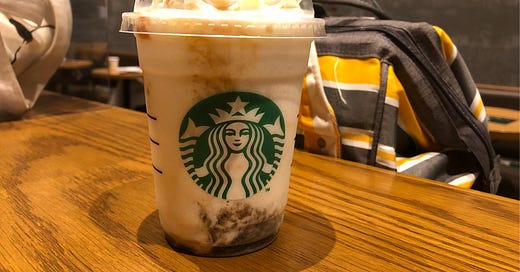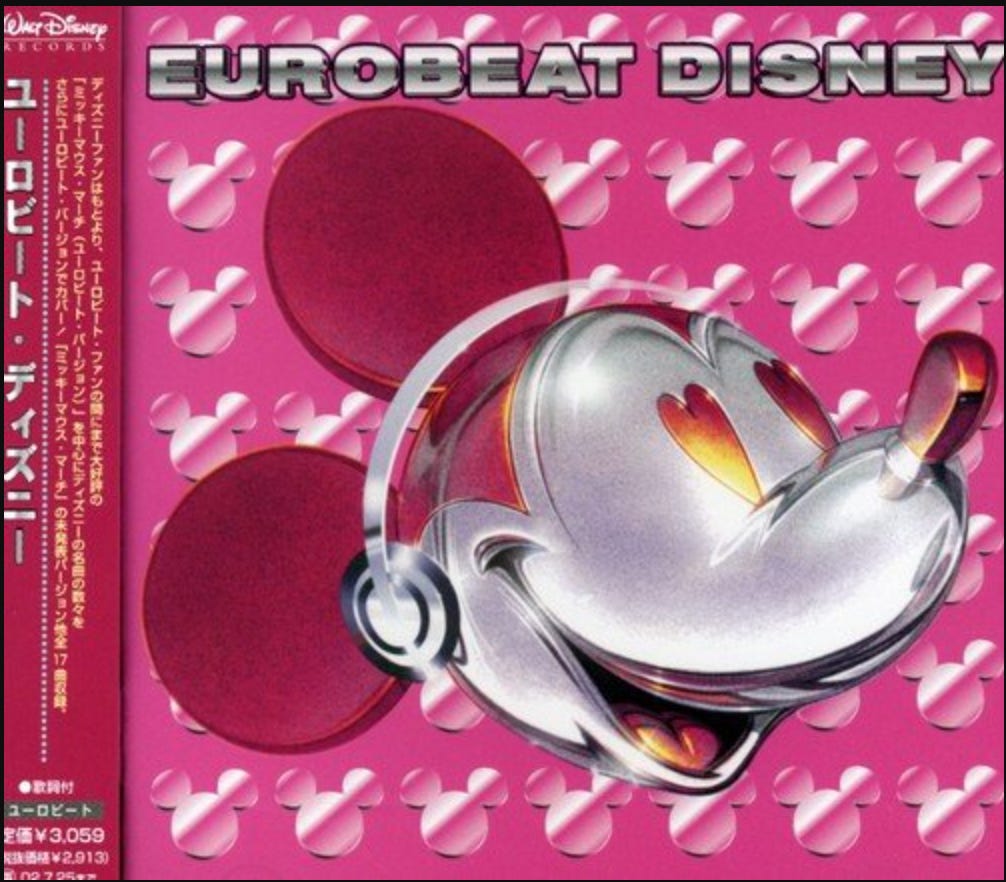Review — Starbucks JIMOTO Frappuccino #12 Chiba
At this point in my criss-crossing Kanto journey, the JIMOTO Frappuccinos I drank didn’t resemble sweets exactly, but more like sugary fruit concoctions. Finally, heading out east, something undeniably dessert-ish! The Chiba offering features a prominent chocolate taste, especially as one works towards the bottom of the cup. It pairs well with the cream on top. This is the first moment I think…what am I doing to my body?
The twist with Chiba Prefecture’s creation is, despite all the sweetness, the star flavor is soy sauce. Owing to the area’s status as the top producer of soy sauce in the nation, this Frappuccino is modeled after a mitarashi dango, an ooey-gooey rice dumpling often covered in a savory soy glaze. The very first sip delivers a rush of that soy taste, and it lingers around as the beverage level decreases. What’s surprising is how it doesn’t stand out from the chocolate and whipped cream taste, but rather fits in just right, never overpowering the other elements. It finds a balance, turning what could be unpleasant into something charming.
Aquasphere Plaza Background Music At Tokyo DisneySea, Composed By Isao Tomita
Tokyo Disneyland — actually based on the far edge of Chiba — presents an all-or-nothing proposition for many. On one side, you have your diehard Disney heads, a strong demographic in Japan, to the point where a monthly magazine devoted to Disney fandom exists. On the other, those who view the Happiest Place East Of Tokyo as a nightmare zone, a place to be avoided at all costs.
I, boringly, fall in the middle. A childhood spent close enough to Disneyland in Anaheim dulled me to whatever escapist qualities it provides. Yet the treks out to Chiba to go to the Tokyo version have never been unpleasant (plus, Tokyo DisneySea is legit great). I’m not rushing out to join the crowds heading into the park, but if a family member wants to hop on that monorail, I’ll happily join.
Though give me the elevated fantasy mall just outside the park any day. Ikspiari, the Tokyo Disneyland version of Downtown Disney, might be the most Southern California part of all Japan. Like the dizzying array of outdoor shopping centers scattered about the southland, Ikspiari features clothing retailers, movie theaters, kiosks selling tchotchkes and emerging trend foods (right now, candy apples, but cut up so they can actually be enjoyed) and chain eateries. Save for the Mickey-fication of everything — imagine a Tommy Bahamas somehow feeling like part of the Lilo And Stitch universe — it feels like home.
Outback Dome
Perhaps more so than any other country, Disney seeps into the fabric of daily life in Japan, whether you are watching TV or heading out to the border of Chiba to drink a Frappuccino. It’s especially true in music, where J-pop stars routinely collaborate with the massive corporation, whether to host tours around the theme park or to work on official songs related to Disney, whether crafting Japanese language tunes for upcoming film releases (you had to sit through the entirety of this Dreams Come True song before Inside Out started) or covering existing hits.
This latter approach has resulted in one of the stranger series of CDs in Japan — the insert-genre-covers-Disney-classics compilation. Available in Disney Stores and Village Vanguards across the archipelago, these collections find artists (sometimes just a single creator or band) putting a genre-specific spin on all those tunes burned into our collective memory. You’ve got your Hawaiian covers, your orgel collections, your wagaki Disney, and so much more. These sets exist in other countries too, but not nearly at the same volume as in Japan.
You’d live a perfectly fine life if you never listened to any of these Disney compilations, as the gems are few and far between. Yet some very interesting installments exist in this series, and if you do want to see how deep this goes, here’s five releases offering an overview of this phenomenon.
V-Rock Disney (2011)
Visual kei remains one of the strongest musical niches in Japan, so much so that Disney could recruit a then-emerging wave of dramatic rockers to turn “Chim Chim Cheree” into a fever dream. Besides predating moody smartphone game Twisted Wonderland by nearly a decade, it’s a good reminder that, for all the flair, visual kei can be pretty self aware of its own ludicrousness (PENICILLIN covering Lilo And Stitch fare).
Mosh Pit On Disney (2004)
Walt Disney Records Japan have revisited this theme — pop-punk and ska covers of their musical vault — multiple times since, including a built-for-this-new-wave collection courtesy of Tokyo Ska Paradise Orchestra. The original, scattered across YouTube, stands out though thanks to a mish mash of domestic and international acts, including Andrew W.K., Reel Big Fish and American Hi-Fi.
Connected To Disney (2019)
The closest the world will come to “Vocaloid Loves Disney.” A handful of rising J-pop stars who emerged from online music communities — including Vocaloid and Vocaloid-adjacent scenes — tackle their favorites. The one drawback? Extremely straightforward, with everyone involved opting to showcase their vocal abilities rather than any of the quirks that make them intriguing. A good reminder, though, that Disney remains plugged in, meaning Ado will probably write an original song for the sequel to Cruella or something.
House Disney (2009)
Walt Disney Records Japan returns to dance music all the time (see: next entry), and their “house” series of compilations features some truly unexpected ideas, like “what if m-flo and Matt Cab covered ‘A Whole New World?’” House Disney though can lay claim to the rarest accomplishment — it’s easily the best album from this series, and maybe the best Disney-commissioned comp of its kind anywhere on Earth. It arrived at a weird intersection of club trends in Japan, with bloghouse burning bright (so 80kidz pop up here) and Yasutaka-Nakata-powered electro-pop also surging (so MEG can sing a digi-brushed ballad), but memories of Shibuya-kei still fresh (hey, Fantastic Plastic Machine, come on down). Uhhh, Kaskade is on here too? A lot is missing from streaming, but it’s worth digging into YouTube to round it out.
Though, really, all you need is Shinichi Osawa’s re-imagined “Main Street Electrical Parade,” an example of the best-case scenario for the intersection of art and commerce, and one of Osawa’s finest tracks period. Finding magic in the Magic Kingdom.
Eurobeat Disney (2000)
One of the laziest activities an English teacher in Japan can engage in is playing a pop song to a class and hoping they absorb it, like some kind of ESL sponge. A veteran instructor will at least make a worksheet allowing the kids to fill in blanks, but the true I-am-just-running-out-the-clock-on-this-class technique is popping in a CD and saying “listen up!” I saw head teachers do this and was guilty of engaging in it while working as an assistant language teacher, though it did lead to one important discovery. On one lazy Tuesday afternoon, the school English teacher decided to play into the student body’s love of Disney by playing them “You’ll Be In My Heart,” from Tarzan. Except she used her Eurobeat Disney compilation, meaning a bewildered set of 13 year olds in 2013 were listening to Dave Rodgers version.
Like the whole of Japan in the 1990s, Disney LOVED Eurobeat, to the point where one of the premier shows at Tokyo Disneyland during that decade featured costumed characters indulging in para para. Naturally, Eurobeat Disney followed, and proved a landmark in Disney’s genre experiments. They released four volumes in the span of two years, topped off by the inexplicable but endearing Eurobeat Disney Presents Winnie The Pooh.
Thanks to their arrival at the start of the 21st century…just as Eurobeat was ceding influence over J-pop to a new palette of sounds…the Eurobeat Disney series makes for a surprisingly great curatorial experience, as the artists brought onboard to turn, like, “Zip-A-Dee-Doo-Dah” into Velfarre material were vital players in Japan’s Eurobeat boom. An accidental ode to a world soon to be eclipsed, delivered with the pep of Splash Mountain.
Written by Patrick St. Michel (patrickstmichel@gmail.com)
Twitter — @mbmelodies







